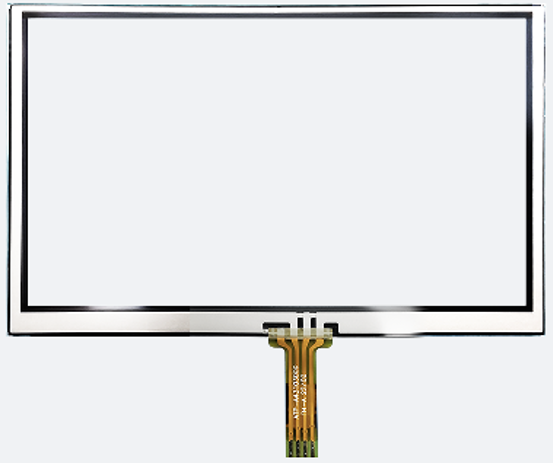We already know that to make the display screen realize the touch function, In-Cell, On-Cell or OGS technology can be used. OGS technology is the most widely used technology at present. This technology can save the cost of a layer of glass and reduce the cost of one-time lamination; at the same time, it reduces the weight of the display screen and increases the light transmittance. OGS can better meet the ultra-thin requirements of smart terminals and improve the display effect. It is the inevitable choice for high-end brand terminals. OGS technology specifically includes several material combinations of G+G, G+P, and G+F. This chapter will introduce you to the meaning of several material combinations and the performance differences.

When we talk about the material composition of touch screens, we often refer to structural classification. The first letter is the surface material of the phone (also called the upper layer), and the second letter is the material of the touch screen (also called the lower layer). The two are bonded together.
G+G means: surface tempered glass + glass touch screen
G+P means: surface tempered glass + PC touch screen
G+F means: surface tempered glass + film touch screen
Let's first understand that the capacitive screen is mainly composed of the lower sensor glass layer and the upper cover plate. There are two types of capacitive screens on the market: one is the sensor glass + tempered glass cover plate structure, referred to as G+G capacitive screen; the second is the sensor glass + PET plastic cover plate structure, referred to as G+P capacitive screen. So what is the difference between the two?
The advantages of G+G capacitive screens are hardness, wear resistance, corrosion resistance, high light transmittance, smooth control feel, and high reliability, while the advantages of G+P capacitive screens are low cost and simple process, but their disadvantages are also very prominent, such as poor wear resistance, corrosion resistance, poor light transmittance, sticky control feel, and poor reliability, which are almost completely opposite to G+G capacitive screens. Let's take a detailed look at the advantages of G+G and G+P capacitive screens:
1. Advantage 1 of G+G capacitive screen: High light transmittance
Capacitive screens are not only used for operation, but more importantly, for viewing and appreciating screen content. The transmittance of the G+G glass capacitive screen is as high as 91%, which has little effect on the screen image, while the transmittance of the G+P PET cover is only 83%, resulting in serious light loss, and the image is inevitably dull and dim. Moreover, the transmittance of the PET cover will gradually decrease over time, which is also a fatal disadvantage of the G+P capacitive screen. 1. Advantage 1 of G+G capacitive screen: hard and wear-resistant。
2. G+G capacitive screen advantage 2: corrosion resistance
The surface of the G+P capacitive screen is plastic, which is easy to harden, become brittle, and change color under the action of acid, alkali, oily substances and sunlight, so it must be used with caution to avoid contact with such substances. If used improperly, it will also produce aerosol and white spots, which is very difficult to handle. The tempered glass surface of the G+G capacitive screen is very corrosion-resistant, and is not afraid of similar substances at all. It can't be affected by strong acids and alkalis. You can use it boldly anywhere, especially when you are eating and operating at the same time, it is inevitable that your fingers will not be stained with grease. The corrosion resistance advantage of the G+G capacitive screen is extremely obvious. The surface cover of the G+G capacitive screen is tempered glass, which is very hard and can reach more than 8H. As long as you don't use quartz, emery paper and other super-hard objects to grind, you don't need to apply a film or worry about scratches. Its disadvantage is that the processing technology is difficult and the cost is high; the surface of the G+P capacitive screen is PET plastic, which is usually only 2~3H hardness, which is quite soft. It is very easy to produce scratches in daily use, and you must apply a film and protect it carefully. Its advantage is simple process and low cost.
3. Advantage 3 of G+G capacitive screen: smooth control feel
The glass screen of G+G is very smooth, and it feels like flowing water when you slide your finger across it, and the operation feels very smooth; while the PET plastic of G+P is a polymer material with a large surface damping force, and the sliding feel is jerky and not smooth, which greatly affects the operating experience.
4. Advantage 4 of G+G capacitive screen: High reliability
The cover plate and sensor glass of the G+G capacitive screen are bonded with advanced optical glue and vacuumed, which has a very high service life and adhesion; the G+P capacitive screen uses PET's own chemical glue for bonding, which is very simple to process, but the bonding reliability is not high. Another important point is that the expansion coefficients of the sensor tempered glass of the G+P capacitive screen and the PET plastic cover plate are very different. At high or low temperatures, the G+P capacitive screen will easily crack due to the difference in expansion coefficients, and thus be scrapped! Therefore, the return rate of the G+P capacitive screen will be much higher than that of the G+G capacitive screen.
5. G+G capacitive screen advantage 1: hard and wear-resistant
The advantages of G+G capacitive screens are hardness, wear resistance, corrosion resistance, high light transmittance, smooth control feel, and high reliability, while the advantages of G+P capacitive screens are low cost and simple process, but their disadvantages are also very prominent, such as poor wear resistance, corrosion resistance, poor light transmittance, sticky control feel, and poor reliability, which are almost completely opposite to G+G capacitive screens. Let's take a detailed look at the advantages of G+G and G+P capacitive screens:
G+G capacitive screen has many advantages, and Hot Display mainly promotes this manufacturing method. Of course, customers can also choose other suitable solutions according to specific product requirements. In any case, Hot Display is always ready to provide the right display solution for your product!
For more details, please contact us directly!







 Search
Search





